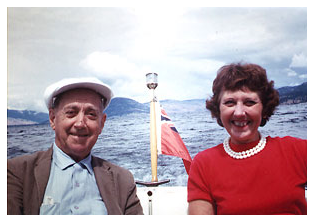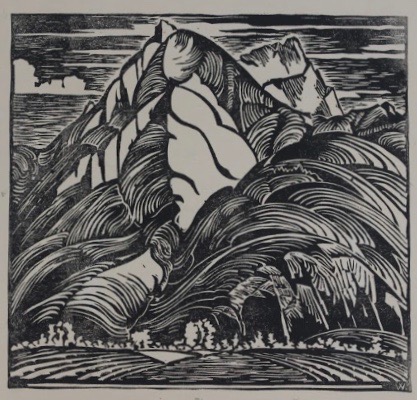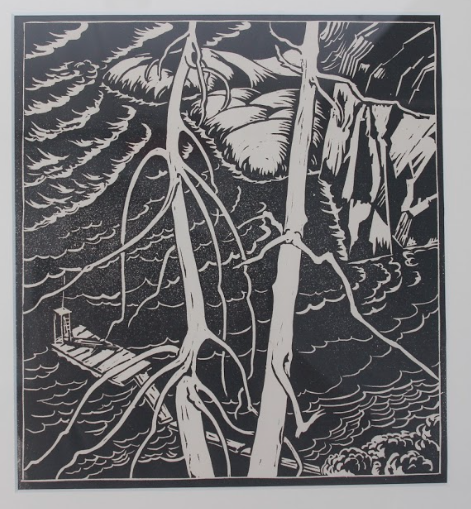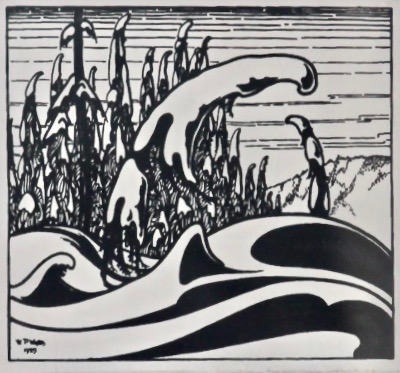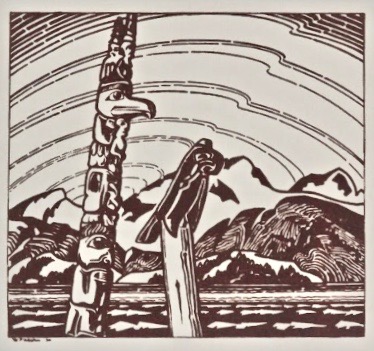W.P. Weston and his daughter on Okanagan Lake, BC.
W.P. Weston
William Percival (W.P.) Weston was born in London and immigrated to Vancouver in 1909, when he was already 30 years old. Trained as a teacher and as an artist, he began to work and exhibit as soon as he arrived, showing work with the British Columbia Society of Fine Arts and teaching at King Edward School.
Weston loved to hike and sail the coastline of British Columbia, sketching en plein air, then working up his sketches in the studio. He was one of the first artists to capture the majestic beauty of British Columbia’s wilderness.
He knew and admired the work of Emily Carr, and corresponded with her regarding ideas and concerns he had in his own work.
As an educator, Weston held a succession of prominent positions.
In 1910 he was appointed Head of Drawing at the Vancouver School Board after only one year of teaching in Canada, and in 1912 became Head of Night School programs. In 1914 he was appointed Art Master at King Edward, and beginning in 1917, would teach 22 terms at the summer school for teachers in Victoria. Throughout all his positions, he emphasized the importance of drawing as the foundation of all art training.
In 1924, Weston co-authored (Charles H. Scott and S.P. Judge) and published The Teacher’s Manual of Drawing and Design. Weston would publish another Teacher’s Manual of Drawing 1932. Both textbooks would become standard in Manitoba and British Columbia. Weston also revised curriculum for British Columbia’s Department of Education.
By the time he retired, (1946) from the King Edward School, (the Provincial Normal School) he was the Art Master. During his career, he taught and influenced many other successful Canadian artists, such as Gordon Smith and Margaret Shelton.
In 1948 he became a member of the Western Group of Painters. An exhibition of his work was held at the Vancouver Art Gallery in 1946 and a retrospective in 1959. He was one of the first BC artists to have a solo exhibition at the Vancouver Art Gallery, after Emily Carr and Thomas Fripp.
Weston’s work possesses all the quality, strength and beauty of his contemporaries, A.J. Casson and Emily Carr, however, he never rose to the same level of fame or commercial success. Perhaps it’s because Weston often gave away his artworks during his career, because his main source of income came from his teaching career, he never needed commercial success, as other artists did.
Surprisingly, in the 1930s and 40s his Weston’s images of British Columbia were considered controversial, and Weston’s images were considered avant-garde at that time. By the 1960s, abstraction became the next major movement, however, Weston resisted change; he believed art should be somewhat representational and continued to create landscapes in his own, distinct style.
W.P. Weston died on Dec 20th 1967, in New Westminster, BC.
Selected Collections
University of British Columbia, Vancouver, BC
Vancouver Art Gallery, Vancouver, BC
The Feckless Collection, Vancouver, BC
National Gallery of Canada, Ottawa, ON
University of Toronto, Toronto, ONT

